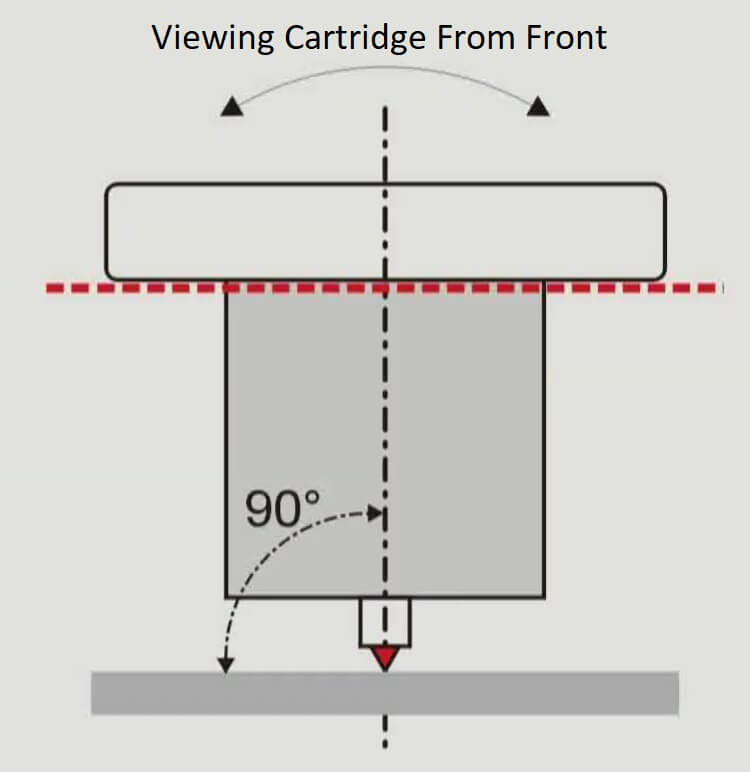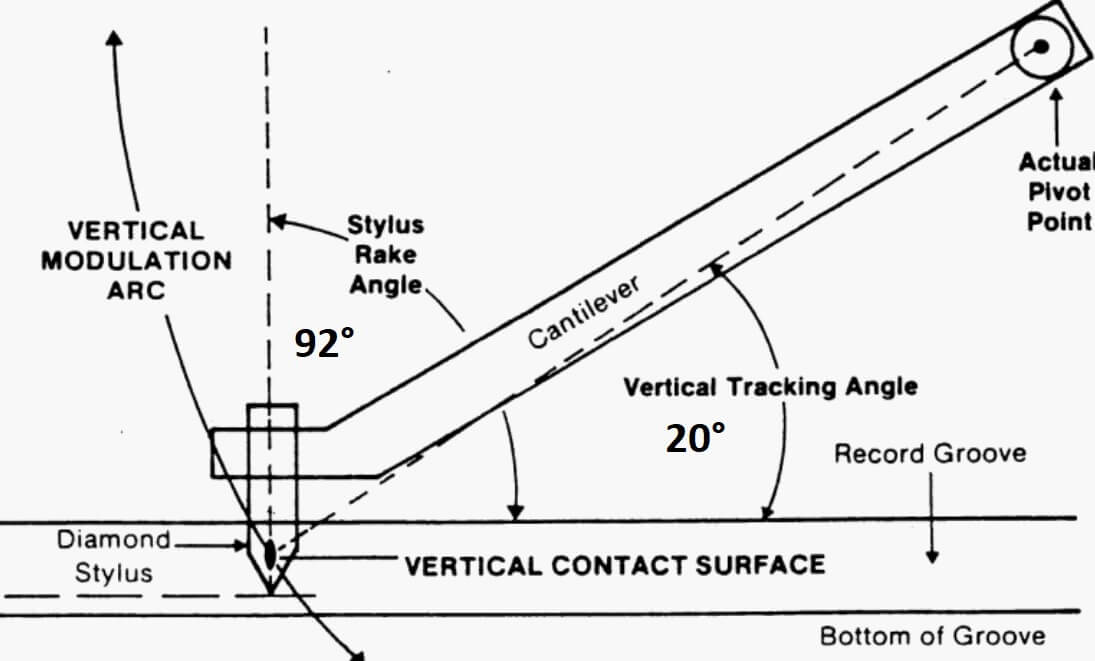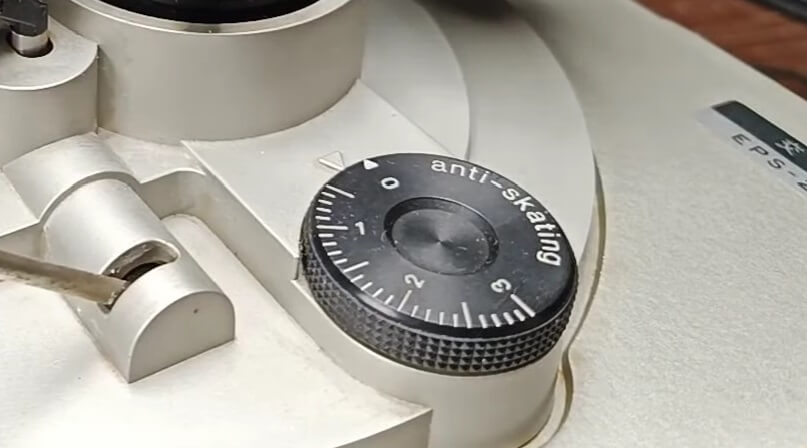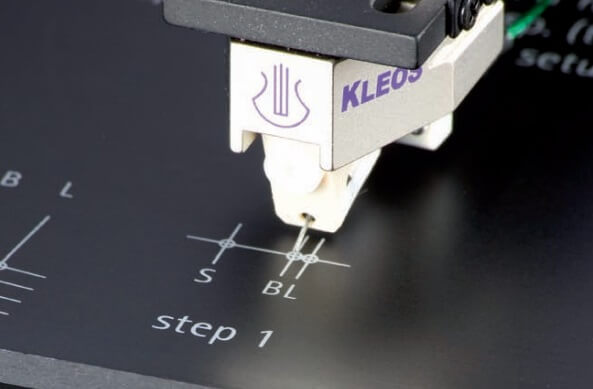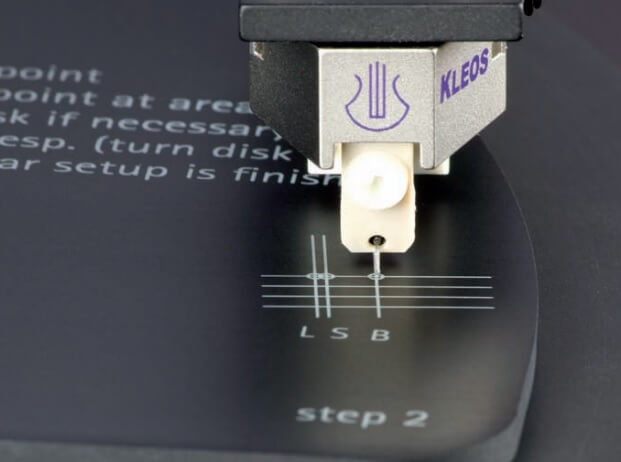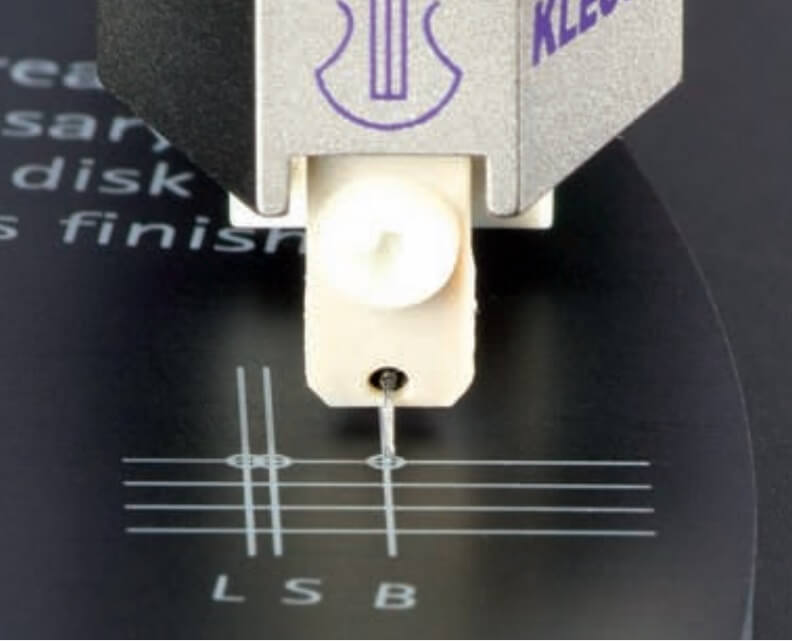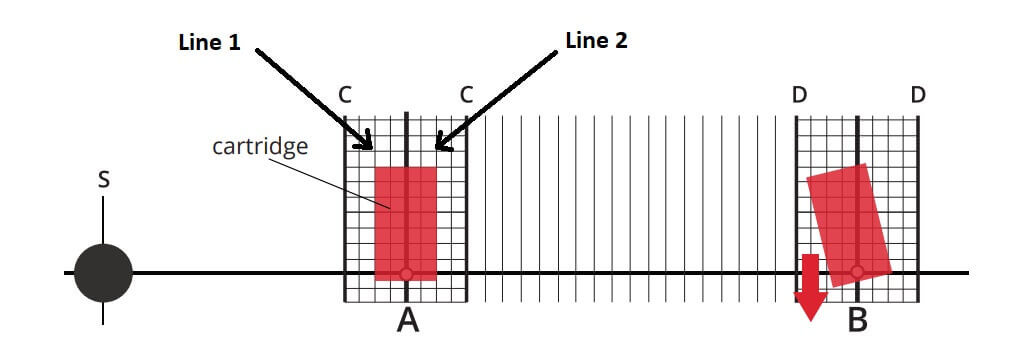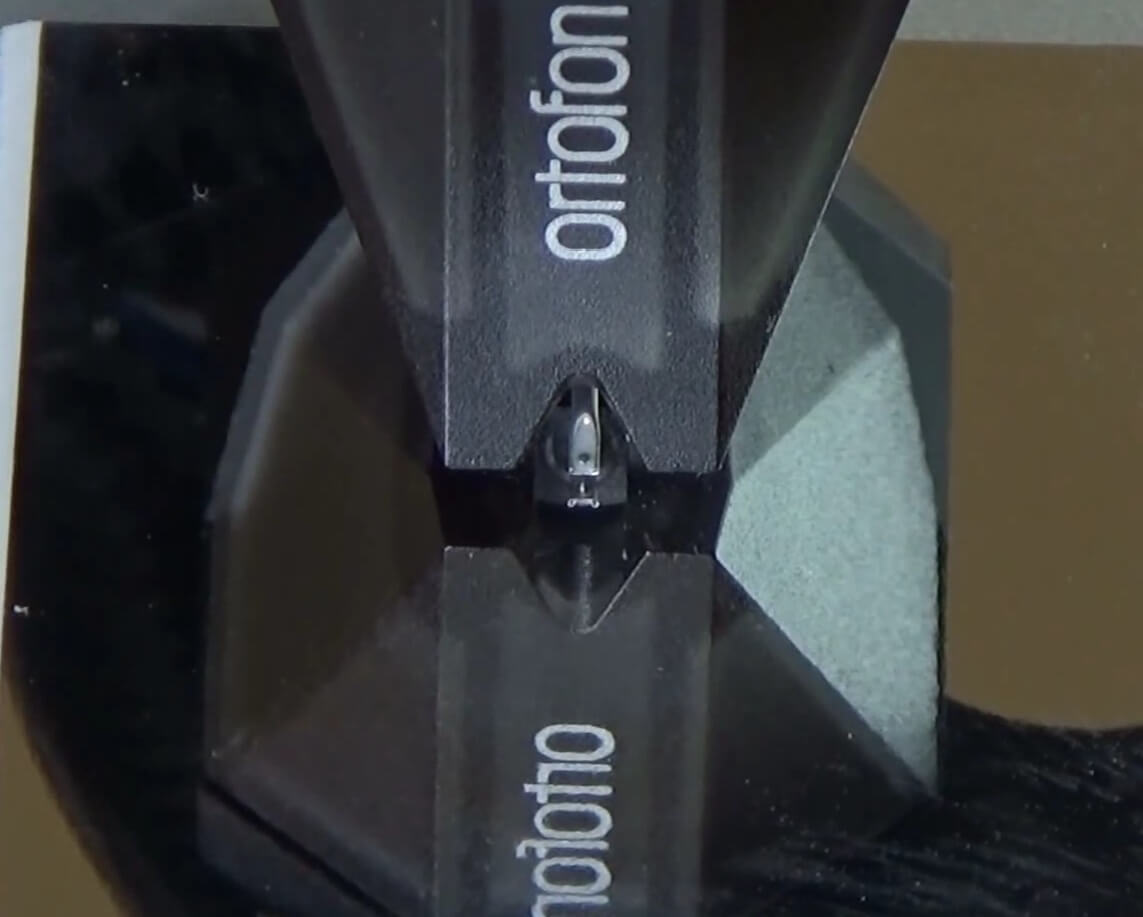The alignment of the cartridge plays a very important role in your turntable’s sound quality. If there is any alignment error then you will hear a lot of distortion while listening to music.
In this article, we are going to cover everything about cartridge alignment, i.e., how to align turntable cartridges, what are cartridge alignment protractors and where to get them for free, what are techniques used for alignment, and much more.
Well, this article is going to be a little technical but I have tried my best to explain it in the easiest way possible so I suggest you free your mind from everything happening in your life and grab a cup of coffee and put all your focus on understanding the alignment concept.
When Do I Need to Align My Cartridge:
This is the most common question that many people have.
Well, the answer is whenever you change your turntable cartridge or you hear sound distortion while playing vinyl, you need to align your cartridge.
Now, let’s discuss the terms or concepts that you must understand to align your cartridge perfectly.
Information About Cartridge Alignment Terms:
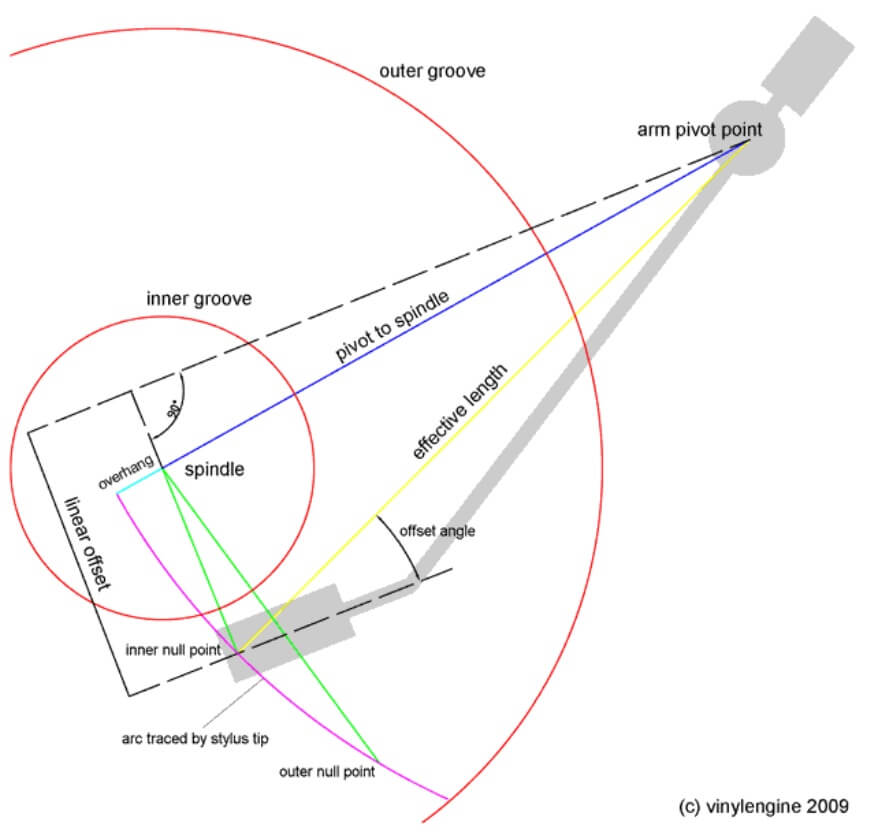
Now, let me explain the points mentioned in the image above:
1) Pivot to Spindle:
The pivot to the spindle is the distance between the center of the spindle to the center point of the tonearm.
2) Arm Pivot Point:
The arm (tonearm) pivot point is the center point of the tonearm.
3) Spindle:
Everyone already knows about this. The spindle is the end point of the motor’s drive shaft in the direct drive turntable and in belt drive and idler drive turntables, the spindle is a little pointed metal tip right in the center of the platter.
4) Effective Length:
The effective length refers to the distance between the tonearm pivot point to the stylus tip.
5) Null Points (Inner Null Point & Outer Null Point):
The null points are the one that helps us in making the cartridge align. We need to adjust our cartridge and headshell so that the stylus tip sits on both null points i.e. inner and outer null points perfectly when recording spins.
6) Offset Angle:
The offset angle refers to the angle between the effective length and the cantilever.
7) Arc Traced By Stylus Tip:
As you know, the stylus creates an arc when running on the turntable. So, the pink arc on the image represents the arc traced by the stylus tip.
8) Overhang:
You might get confused in this so please divert all your focus here. I am giving you an example that is not practical but you will understand the overhang better with this.
Suppose, you have moved your tonearm over the spindle and the stylus tip sits right on the center of the spindle. In this case, the overhang will be 0mm which won’t happen most of the time.
In real, when you move your tonearm over the spindle, you will see that there is some distance between the stylus tip and the spindle’s center point. That distance is known as an overhang.
Normally, you will find an overhang in the 12 to 16mm range.
9) Grooves (Inner Groove and Outer Groove):
This represents the inner grooves section and outer grooves section of the record.
The proper understanding of the above image and its meaning is very important because, without it, you won’t be able to align your cartridge perfectly.
So, I recommend you to go through the image carefully and try to understand it. If you have any questions then you can comment below, and we will answer your query.
So now, let’s move further and discuss the protractors and alignment techniques.
What is a Cartridge Alignment Protractor:
A cartridge alignment protractor refers to a tool that helps us align our cartridge and stylus to achieve perfect sound quality from our turntables.
It has printed tangent lines and specific null points that are calculated through pure math and when adjustment is done according to this tool, the stylus tracks the grooves better and any sort of distortion is minimized thus a perfect sound quality is achieved.
Cartridge Alignment Techniques:
There are 3 types of techniques:
Technique 1: Baerwald
The Baerwald alignment technique helps in making the distortion even across the entire record. The null points are 66.0 and 120.9 mm.
Technique 2: Loefgren
The Loefgren alignment technique helps in minimizing the distortion across the record. The null points are 70.3 and 116.6 mm.
According to the Fluance support section, fluance turntable uses the Lofegren alignment method but the manual they provide on their website is for Baerwald alignment.
Technique 3: Stevenson
The Stevenson alignment technique helps in minimizing the inner groove distortion across the record. The null points are 60.325 and 117.42 mm.
Rega turntable’s tonearm are Stevenson type and they usually offer the Stevenson cartridge alignment protractor along with their turntable accessories.
So, these are 3 alignment techniques and now, let’s discuss which alignment technique you should use.
Which Cartridge Alignment Method or Technique You Should Use:
This question is a long unanswered question.
Well, I have read multiple forums and articles online to find the method preferred by most of the users and in the end, I can say that there is no preferred method.
Everyone uses the alignment method depending on their tonearm characteristics and their personal choice.
Normally, the cartridge alignment protractor is provided along with other accessories but if not then you can contact your turntable’s customer support and ask them about your tonearm’s recommended alignment method.
Which Cartridge Alignment Method I Use:
I use the Stevenson alignment technique which suits best with my turntable’s tonearm and I am totally satisfied with this method.
How To Get Free Alignment Protractors:
Method 1: Vinyl Engine
Vinyl Engine provides a free alignment protractor that you can print at your end. Here is the step-by-step guide to download the free protractor from the Vinyl engine:
Note: Vinyl Engine has currently disabled new registrations on their website and to download a free protractor, you need to have an account at Vinyl Engine. So, if don’t have an account then follow other methods we have shared.
Steps:
- Go to VinyEngine
- Click on the protractor image that you want to download
- Create a new account or login to your existing account
That’s it. You can download the protractor for free and print it out.
Method 2: Audio Technica (Stevenson)
You can directly download the Stevenson protractor from the audio technica website.
Method 3: Fluance (Baerwald)
You can directly download the Baerwald protractor from the fluance website.
I hope you got your free protractor so let’s dive deeper and discuss the goal that we want to achieve with cartridge alignment:
Turntable’s Cartridge Alignment Goal:
Front View:
The azimuth concept needs to be applied here.
Side View:
This is our goal for cartridge alignment. I know, these signs and angles can confuse you but don’t worry, I got you covered. I will explain everything so just keep reading the article.
Well, let’s discuss the new terms that are mentioned in the image above with angles i.e.
- Vertical Tracking Angle (VTA)
- Stylus Rake Angle (SRA)
- Azimuth
Vertical Tracking Angle (VTA):
The vertical tracking angle plays a very important role in awesome sound quality. It refers to the angle between the cantilever and the record surface.
According to different online resources, the recommended VTA is 20°.
Stylus Rake Angle (SRA):
The stylus rake angle refers to the angle at which the stylus comes in contact with the record grooves.
From the image shared above, you can see that in the front side view, I have mentioned that the angle should be 90° but on the side view, I have mentioned that angle should be 92°.
Well, there is a strong reason behind the 92° angle adjustment.
According to multiple resources online, the master discs get cut at a 92° angle so to help our stylus track the grooves better, we should implement the same on our turntable.
Now, you might have questions like why 92°?
Right?
Well, let me answer it.
Why LPs are cut at 92 degrees?
The 92 degrees is a level that is assumed to produce the lowest number on a measurement called intermodulation distortion. Let’s not dive deep into intermodulation distortion; otherwise, we will deviate from our real topic.
If you want to learn more about intermodulation distortion then check out this article.
Azimuth:
The azimuth refers to the balance of the stylus when it sits in the record grooves. The stylus should not be tilted to the left side or right side, it should be perfectly balanced in the center. For a more details explanation, check the image below:
The first one is our goal to achieve.
So, these are 3 terms that you must know before aligning your cartridge. Now, let’s proceed further and let’s learn the cartridge alignment process.
How To Align Turntable Cartridge or Stylus Using Cartridge Protractor:
Here is the step-by-step guide:
Step 1:
Turn off the turntable and remove the power cord from the power outlet.
Step 2:
Place the protractor on the platter. In this guide, we are using Dr. Feickert’s analogue universal protractor but you can use any protractor of your choice.
Step 3:
Choose the alignment technique that you want to use i.e. Baerwald (B), Lofgren (L), or Stevenson (S). In this guide, we will be using Baerwald geometry.
Step 4:
Set the Anti-skating to Zero and free your tonearm from its lock.
Step 5:
Move the tonearm over the platter and unscrew the headshell’s screw slightly. Make sure you unscrew enough that the cartridge is moving with slight pressure, not until the cartridge drops off the headshell.
Step 6:
In most of the protractors, you will see 2 null points. You can start with the null point near to outer groove but in Dr. Feickert’s analogue universal protractor, the steps are already mentioned on the protractor so we will be proceeding further according to the protractor.
So, set the cueing device down and place the stylus tip in the middle of the ‘X’ mark on the protractor in step 1.
Here, B represents the Baerwald technique, L represents the Lofgren technique and S represents the Stevenson technique.
As we are using the Baerwald technique in this guide, we will see placing the stylus tip on the middle of the ‘X’ mark represented as B.
Step 7:
Carefully tighten one screw of the headshell and make sure the cartridge is still movable with some pressure.
Step 8:
Pick up the tonearm and move the platter until your stylus reaches step 2 printed on the protractor.
Step 9:
Try placing the stylus tip right on the center of the ‘X’ mark on B in step 2. If you got the center then you are almost done but if not then keep adjusting the cartridge until you get the center of the ‘X’ mark on B in step 1 and the ‘X’ mark on B in step 2 by just moving the platter and finally, tighten the headshell’s screws.
In most of the protractors, there are just 2 null points but in Dr. Feickert’s universal protractor, there are 3 null points. If you have successfully aligned the cartridge to the 2 null points then the 3rd one will be aligned automatically.
Step 10:
Now, you need to adjust the Azimuth. If you don’t know about this term then please check the article above, we have explained it.
Goal: Our goal is to achieve a perfect 90° angle of the stylus.
Using Dr. Feickert’s analogue universal protractor:
You need to align the cantilever to the line printed before and after the ‘X’ mark by looking from the front side.
Using Normal Protractor:
You need to parallel align the cartridge body with line 1 and line 2.
Mirror Method:
You can use a small mirror under the stylus tip from where you can align the cartridge and make the cartridge’s front side look straight in the mirror.
Step 11:
After setting azimuth, you can set VTA and SRA by balancing the tonearm. Well, if you are a normal listener then you don’t need to set VTA or SRA so let’s not get into these parts.
But, if you still want me to explain the vertical tracking angle (VTA) or stylus rake angle (SRA) then please comment below and I will publish a full guide on these two setups.
Now, test everything again and make sure, you did the alignment perfectly.
If not, then I suggest you start from the beginning and get it perfectly aligned.
Well, this process tests your patience so let’s not lose our patience and focus on aligning it perfectly to get the best sound quality you could ever hear from your turntable.
That’s it. You have successfully aligned your turntable cartridge using protractors.
Frequently Asked Questions:
Q1- Are turntable protractors universal?
In most of the turntables, the protractors are universal but if you talk about an old record player or turntable with a specific cartridge, then you need to use a specific protractor that is supplied with the unit.
Q2- What is the angle of a cartridge alignment?
The vertical tracking angle (VTA) should be 20°, the stylus rake angle (SRA) should be 92° and the azimuth should be 90° to allow the stylus to track the record grooves efficiently.
Q3- What are the two types of protractors?
There are two types of protractors:
- Circular Protractor
- Semicircular Protractor
The circular protractor is just like felt met i.e. 360 degrees which covers the whole platter while on the other hand, the semicircular protractor covers only half of the platter i.e. 180 degrees.
Q4- Why protractor is used?
The protractor is made with pure geometry, i.e., by keeping in mind the different aspects required for the stylus to maintain its position right in the center of the grooves at different positions on the record to achieve the perfect sound quality from a turntable setup.
So, using a protractor makes our job easy to align our cartridge without measuring and calculating the geometry ourselves in real time.
We have explained the cartridge alignment concept and how to align the turntable cartridge and stylus using a cartridge protractor. If you have any questions then you can comment below. We will get back to you as soon as possible.

